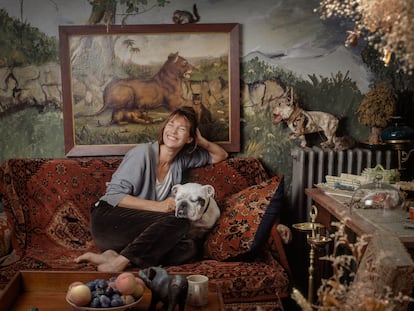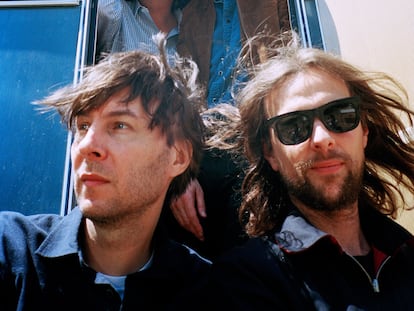Eccentricity, success and tragedy: the enigmatic Mylène Farmer, France’s most elusive superstar
The singer and composer of the chart-topping ‘Désenchantée,’ who has sold more records in France than any other artist since the eighties, rarely appears in the media and has become a cult hero with a large and loyal fanbase.
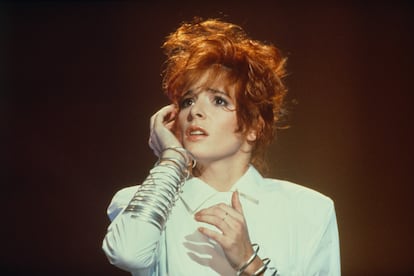
The riots that erupted in France in late June had an unintended consequence: the cancellation of two concerts by Mylène Farmer’s, scheduled for June 30 and 31 at the Stade de France in Saint Denis, Paris. For fans of the famed French singer — a singular cult hero whose tours are always ambitious, million-dollar super-productions — the news was a bitter pill to swallow. Due to the sheer scale of the show, with its complicated and kinetic stage architecture, it was impossible to move the event to a different stadium, and because of the Rugby World Cup and the Olympic Games, which are being held at the same venue, Farmer’s performances have now been postponed until September 2024. As usual for France’s most elusive, controversial and undisputed superstar, tickets for the new concert dates, which went on sale on July 18, sold out almost immediately.
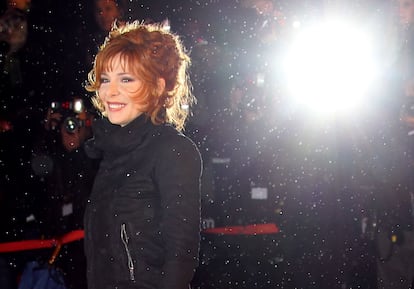
Mylène Farmer, who refuses to have a social media presence and has always declined to have her own website — her only official online presence are the websites that sell tickets to her shows — has sold more records (over 30 million) than any other artist in France in recent decades, and has enjoyed the most No. 1 singles (over twenty) on the French charts than any artist in history. Her tours sell out in a matter of hours: tickets for this summer’s performances went on sale in October 2021, selling over half a million seats for thirteen different performances. These figures may seem small when compared to the towering giants of the Anglo-Saxon industry (Madonna, Ed Sheeran and Elton John being the reigning champions in that domain), but they have hardly any comparison in France, and by extension, in the rest of continental Europe.
Farmer’s unparallel success is impressive given that, compared to other French stars like Étienne Daho or Françoise Hardy, she is essentially a cult figure — a kind of star-in-spite-of-herself, and a singular artist who is quite difficult to classify. In Spain, for example, she is best known indirectly, through dance covers of two of her classics, Désenchantée and Libertine, recorded by the Belgian singer Kate Ryan in the early 2000s, and also through her collaborations with the young French singer Alizée, whose career was nurtured by Farmer and her songwriter and collaborator Laurent Boutonnat as a kind of adolescent version of the cult star herself. If listeners around the world welcomed Alizée’s Moi… Lolita as a smash hit with a fresh new sound, it escaped precisely no in France that the song’s synth-pop style and bouncy lyrics, full of riddles and puns, was straight out of Farmer’s playbook.
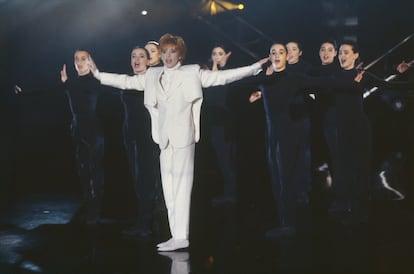
The greats all have their adjectives, but there is something in the career of the French-Canadian superstar that resists categorization. This nonconformity has not stopped rivers of ink from flowing on the life and work of the artist, however. Dozens of books have been published on Farmer — a friend of Sting and Salman Rushdie — that range from granular analyses of her cryptic song lyrics and videos, to more-or-less psychoanalytical interpretations of her artistic and personal universe. She has been rumored to be a high-ranking member of the Free Masons (or a Satanic priestess). Some say she lives in the dark, in the company of two capuchin monkeys (she did, in fact, have a pet monkey named E.T. for 25 years), or that she eats spiders (which is not true, though her biographers do claim that she has a somewhat manic relationship with food).
She is a vampiric figure, who feeds, above all, on the gothic, ambiguous and unsettling image she cultivated for herself in her early years. At a time when French pop was floating high on the euphoric melodies of Jeanne Mas or Princess Stephanie of Monaco, Farmer’s songs were inspired by passages from Edgar Allan Poe and Baudelaire, and her videos — splendidly conceived by her long-time collaborator, and the film director who discovered her, Laurent Boutonnat — were big-budget period short films, sometimes so explicit in their violence and sexual energy that they could only be aired in the middle of the night.
The audition was the first time Mylène had ever picked up a microphone: she had always wanted to be an actress, not a singer. But her vocal gift, with a low bass and the falsetto of a child, complemented Boutonnat’s electronic beats perfectly, and a creative duo was born. For three decades, Boutonnat composed and recorded instrumental demos while Farmer wrote lyrics to accompany them. A new and unique style emerged: catchy and emphatic melodies, but with lyrics like complicated word games, full of literary allusions and poetic quotations about love, sex, anxiety, melancholy and death.
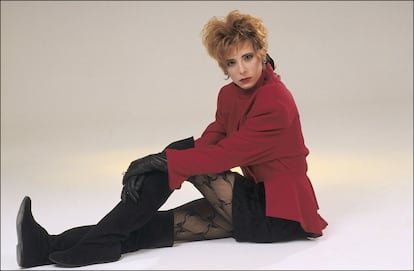

In the first decade of her career, Farmer’s music videos were often up to 15 minutes long and added a layer of historical complexity to her work. This was an era when Michael Jackson was producing audiovisuals with a bigger budget than many full-length European films, and Boutonnat would not aspire to anything less. In Libertine, a sort of lesbian-feminist version of Stanley Kubrick’s 1975 drama Barry Lyndon, Farmer plays a reckless adventuress who duels with a man after stealing his bride. Tristana is a version of Snow White with incestuous overtones, while Sans contrefaçon employs the metaphor of the puppet — something between Pygmalion and Pinocchio — to address the singer’s experience with gender ambiguity during her childhood and adolescence. “I always felt between two sexes. I didn’t try to explain it to myself, that’s just the way it was: I was undefined,” she told Elle magazine in 1989. Her self-image was a reflection of a neo-romantic aesthetic that played with images of androgyny, which continue to inform her appearance: an always-pale complexion, set against flame-colored hair, with a wardrobe style that oscillates between swashbuckling pirate and corseted cabaret dancer.
In 1991, it was the first single from Farmer’s third album that triggered the cultural fever: “Désénchantée”, a song that, in the words of her biographer Hugues Royer, “had all of France dancing to its desperate lyrics.” In the video, Farmer transforms into an androgynous union agitator in the early days of the Industrial Revolution, and organizes a revolt against child labor that ends in an anticlimax: after their liberation, the children become lost in a snowstorm. The artist’s veneration of childhood as a romantic and uncertain phase of life is notable given Farmer’s confession to the Belgian writer Amélie Nothomb, in the mid-1990s, that she had hardly any precise memories before the age of 12. One exception was her vacations to Normandy, where her grandmother introduced her to what would become a life-long passions: visiting cemeteries, which, as she explained in a 2006 TV interview, are places where she “can rediscover [her] center.” The obsession has never faded: in the theatrics for her current tour, the stage becomes momentarily transformed into a cemetery, reminiscent of the one where she shot some of her previous music videos, such as “Regrets”.
Farmer’s media presence is atypical for an artist of such fame and stature. Her biographers say that from the very early days of her career, it was clear that the model of fame Farmer wanted to emulate was that of Greta Garbo (to whom she would dedicate one of the songs on her first album): never talk about her life, never give explanations. Farmer, who says she tends to feel violent in the presence of journalists, is not fond of institutional recognition. In 1988, she won best female artist of the year at Les Victoires de la Musique, accepting the award with a stiff and unfriendly speech, and refusing to sing live. “These are awards for hypocrisy,” she would later say of the tense atmosphere she sensed during rehearsals. “Everyone hates each other,” she declared.
Farmer thus occupies an ambivalent place in the French cultural landscape. On the one hand, she is a money-making machine: even today, with physical formats disappearing, each of her releases branches out into endless limited editions, reissues of previous albums and singles, new remixes, and a virtually infinite stream of merchandise that sells out as soon as it’s released. She is a sophisticated artist, but her public position has exposed her to scathing criticism, in part because of her LGTBIQ+ fanbase, her gothic imaginary, and her insistence on maintaining a thematic repertoire. Over the years, her detractors have characterized Mylène Farmer’s audience as primarily gay, provincial, with depressive tendencies and an unhealthy obsession with their idol.
The image of Farmer’s audience as a kind of cult, and Farmer as a cult leader — a characterization fed by urban legends and denied by those closest to the artist, who describe her as an ordinary person with a peaceful and conventional life — was fostered by an event that would forever change the singer’s relationship with the public. In 1991, a fan showed up at the headquarters of Farmer’s record company, Polydor, asking for her home address. When the receptionist refused to give him the address, the fan pulled out a gun and shot him. The death of the Polydor employee was not only a macabre event that traumatized the artist, who took more than a decade to speak publicly about it; it also marked a turning point in her career, which entered a dark phase at the height of her success. The first half of the 1990s would prove a difficult period for both her and Boutonnat. The composer and filmmaker, who had always dreamed of directing and had orchestrated Farmer’s music videos as a preamble to his great work, released the film Giorgino in 1994, a nearly three-hour-long epic co-starring the singer herself. It was a total flop: an overpriced film that ate Boutonnat’s million-dollar savings and barely lasted a few weeks in theaters.
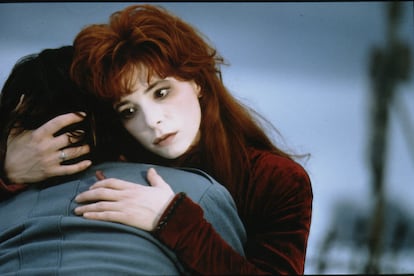
The most noticeable transformation in the artist’s long career was her radical reorientation to fame. The superstar who performed “Désenchantée” had always had her ups and downs with the press, but beginning in the mid-nineties, she became something of a hermit. She started refusing interview requests and refusing to appear in public, with the exception of during her tours, which employed an extravagant, super-production model inspired by the performances of Madonna and Michael Jackson.
Only in the last decade has Farmer started to work with composers and producers other than Boutonnat. L’Emprise (2022), her latest album, is a collaboration with French musician Woodkid, famous for his electronic production featuring symphonic echoes and epic rhythms. Recently, Farmer returned to cinema, playing a role in Pascal Laugier’s Ghostland. Meanwhile, her early career is enjoying something of a renaissance, with a modern generation of fans who can appreciate her music and videos without the prejudices of the past. The French version of the show Drag Race has organized imitation contests based on Farmer’s most emblematic looks, and in July 2022, the fashion show hosted by Olivier Rousteing for Gaultier’s line of haute couture was set entirely to the music of a remix of Sans contrefaçon, highlighting a long-standing affinity between the singer and the brand: Jean Paul Gaultier, a personal friend of the artist, has signed several of her most memorable outfits.
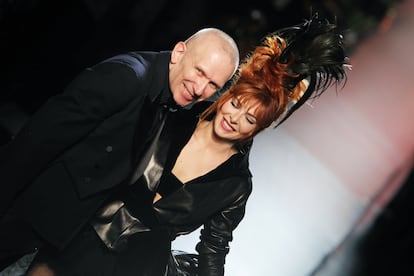
At the same time, Les Inrockuptibles, the unofficial bulletin of the French culture industry, dedicated a recent feature to the singer that attempts to explain the persistence of her popularity. Among the voices consulted for the piece is the singer Juliette Armanet, one of France’s latest pop sensations. “Mylène is THE French star. I was raised on here as a teenager and she’s always managed to transcend time and stay modern,” she says in the piece, and goes on to detail the artist’s many merits: “She inspired debates on gender, identity and sexuality, in her lyrics as much as in her visual art, her costumes, her video clips and her image work. She liberated us all, drawing us in and dragging us along with her career. Her cult of mystery made her an absolute icon. She acts, systematically, like a magical apparition.” Together with her enigmatic presence, Farmer’s appeal is largely in her ability to connect with an audience that, decade after decade, tour after tour, continues to fill stadiums to watch her perform fantasies and to chant pop anthems that are less naive than they at first might seem.
On July 14, a few seconds after the start of the audiovisual introduction to her concert in Bordeaux, a summer storm unleashed a downpour over the open-air stadium. The singer, who emerged, as if by magic, from a flock of crows, greeted the audience and walked down the cross-shaped catwalk, singing in the rain and ignoring the storm, which would stop a few minutes later — a stage entrance that, four decades after her stormy irruption onto the French pop scene, once again surpassed the powerful presence her fans continue to expect from her.
Sign up for our weekly newsletter to get more English-language news coverage from EL PAÍS USA Edition
Tu suscripción se está usando en otro dispositivo
¿Quieres añadir otro usuario a tu suscripción?
Si continúas leyendo en este dispositivo, no se podrá leer en el otro.
FlechaTu suscripción se está usando en otro dispositivo y solo puedes acceder a EL PAÍS desde un dispositivo a la vez.
Si quieres compartir tu cuenta, cambia tu suscripción a la modalidad Premium, así podrás añadir otro usuario. Cada uno accederá con su propia cuenta de email, lo que os permitirá personalizar vuestra experiencia en EL PAÍS.
¿Tienes una suscripción de empresa? Accede aquí para contratar más cuentas.
En el caso de no saber quién está usando tu cuenta, te recomendamos cambiar tu contraseña aquí.
Si decides continuar compartiendo tu cuenta, este mensaje se mostrará en tu dispositivo y en el de la otra persona que está usando tu cuenta de forma indefinida, afectando a tu experiencia de lectura. Puedes consultar aquí los términos y condiciones de la suscripción digital.
More information
Archived In
Últimas noticias
There is as much life left to discover on planet Earth as that which is already known
Dozens presumed dead, around 100 injured in fire at Swiss Alps bar during New Year’s celebration
Is porn for women different from conventional porn? We spoke to those who make it
Cartagena de Indias is sinking: What can the city do to mitigate it?
Most viewed
- Reinhard Genzel, Nobel laureate in physics: ‘One-minute videos will never give you the truth’
- David King, chemist: ‘There are scientists studying how to cool the planet; nobody should stop these experiments from happening’
- Sinaloa Cartel war is taking its toll on Los Chapitos
- Oona Chaplin: ‘I told James Cameron that I was living in a treehouse and starting a permaculture project with a friend’
- The Interoceanic Train, the Mexican alternative to the Panama Canal

